Queen Of Sheba
 From Nwe
From Nwe 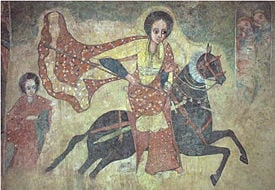
The Queen of Sheba, (tenth century B.C.E.), also known as Makeda (Ethiopian), Nicaula (Roman), and Bilquis (Arabic), was the ruler of an ancient kingdom located in the areas called Ethiopia and Yemen today. She is mentioned in the Hebrew Bible and the Holy Qu'ran as a prominent visitor to King Solomon's court. Many legends surround her relationship with King Solomon, which often depict them as lovers. The biblical text, Song of Solomon (Song of Songs), contains some references, which at various times, have been interpreted as referring to love between Solomon and the Queen of Sheba. The young woman of the Song of Songs continues to deny the romantic advances of her suitor, whom many commentators identify as King Solomon. However, there is little to identify this speaker in the text with the rich and powerful foreign queen depicted in the Book of Kings. The woman of the text of the song clearly does regard "The Daughters of Jerusalem" as her peer group.
Etymology
Sheba may be derived from the ancient Egyptian word for star. According to the eleventh century geographer Yaqut al-Hamawi, the star-worshipers of Harran in Turkey, and those from Yemen, went on special pilgrimages to the pyramids of Giza. The Queen of Sheba may have referred to the Kandake's title when acting as the chief astronomer or high priestess of a star-venerating religion that was centered in Africa, with satellite centers in Arabia, Asia, and Europe.
The "star-worshipers" also studied or venerated the sun and moon and, roots of their practice dates back to well before 5000 B.C.E. Evidence for a level of sophistication and knowledge of astronomy has been found at several archaeological sites in Africa, including the complex at Nabta Playa in southern Egypt. The structure at Nabta is almost 7,000 years old, and is the oldest astronomical complex in the world.
Other astronomical sites in Africa include: Namoratunga II, near Lake Turkana, in Kenya, which was in use around 300 B.C.E.; the Senegambian stone circles; and the Bouar megaliths in what is now the Central African Republic.
There also have been claims by some scholars that the ancient Egyptian name Hatshepsut translates as "Queen of Sheba."[1] Hatshepsut was a pharaoh of Egypt, born c. 1508 and died 1458 B.C.E., who revived active trade with neighboring kingdoms and created a flourishing and prosperous economy for her eighteenth dynasty kingdom. She is recorded as having traveled widely as well.
The etymology of her Ethiopian name, Makeda, is uncertain, but there are two principal opinions about its Ethiopian source. One group, which includes the British scholar Edward Ullendorff, holds that it is a corruption of "Candace," the Ethiopian queen mentioned in the New Testament Acts; the other group connects the name with Macedonia, and relates this story to the later Ethiopian legends about Alexander the Great and the era of 330 B.C.E.
The Italian scholar Carlo Conti Rossini, however, was unconvinced by either of these theories and, in 1954, stated that he believed the matter unresolved.[2]
Textual accounts
Hebrew Bible
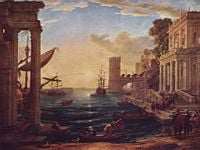
According to the Hebrew Bible, the unnamed queen of the land of Sheba heard of the great wisdom of King Solomon of Israel and journeyed there with gifts of spices, gold, precious stones, and beautiful wood and to test him with questions, as recorded in First Kings 10:1-13 (largely copied in 2 Chronicles 9:1–12).
It is related further that the queen was awed by Solomon's great wisdom and wealth, and pronounced a blessing on Solomon's deity. Solomon reciprocated with gifts and "everything she desired," whereupon the queen returned to her country. The queen was apparently quite rich, however, as she brought 4.5 tons of gold with her to give to Solomon (1 Kings 10:10).
Qur'an
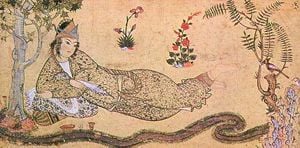
The Qur'an, the central religious text of Islam, never mentions the Queen of Sheba by name, although Arab sources name her Balqis or Bilqis. The Qur'an account is similar to the one in the Bible. The Qur'anic narrative has Solomon getting reports of a kingdom ruled by a queen whose people worship the sun. He sent a letter inviting her to visit him and to discuss his deity, related as Allah, the Lord of the Worlds (Alamin) in the Islamic text. She accepted the invitation and prepared riddles to test his wisdom and knowledge. Then one of the ministers of Solomon (who had knowledge of the "Book") proposed to bring him the throne of Sheba "in the twinkling of an eye" (27:40). The queen arrived at his court, was shown her throne, entered his crystal palace, and started asking the questions. She was impressed by his wisdom and praised his deity. Reportedly, she eventually accepted Abrahamic monotheism.
Ethiopian texts
An ancient compilation of Ethiopian legends, Kebra Negast ("the Glory of Kings"), relates a history of the Queen of Sheba (named Makeda, "pillow," in Ethiopian writings) and her descendants. In this account, King Solomon is said to have seduced the Queen of Sheba and sired her son, Menelik I, who would become the first Emperor of Ethiopia.
The narrative given in the Kebra Negast—which has no parallel in the Hebrew Biblical story—is that King Solomon invited the Queen of Sheba to a banquet, serving spicy food to induce her thirst, and inviting her to stay in his palace overnight. The Queen asked him to swear that he would not take her by force. He accepted upon the condition that she, in turn, would not take anything from his house by force. The Queen assured him that she would not, slightly offended by this intimation that she, a rich and powerful monarch, would engage in stealing. However, as she woke up in the middle of the night, she was very thirsty. Just as she reached for a jar of water placed close to her bed, King Solomon appeared, warning her that she was breaking her oath, water being the most valuable of all material possessions. Thus, while quenching her thirst, she set the king free from his promise and they spent the night together.
Thus, Ethiopian tradition firmly asserts that King Solomon did seduce and impregnate his guest, which is a matter of considerable importance to Ethiopians—as their emperors traced their lineage to that union. The tradition that the Biblical Queen of Sheba was a ruler of Ethiopia who visited King Solomon in Jerusalem, in ancient Israel, is supported by the first century C.E. (of Jewish origin) historian Flavius Josephus, who identified Solomon’s visitor as a "Queen of Egypt and Ethiopia."
Other Ethiopian accounts make her the daughter of a king named Agabo or Agabos, in some legends said to have become king after slaying the mythological serpent Arwe; in others, to have been the 28th ruler of the Agazyan tribe. In either event, he is said to have extended his Empire to both sides of the Red Sea.
The imperial family of Ethiopia claims its origin directly from the offspring of the Queen of Sheba by King Solomon. Thus for the Ethiopian monarchy, the Solomonic and Sheban lineage was of considerable political and cultural importance. Ethiopia had been converted to Christianity by Egyptian Copts, and the Coptic Church strove for centuries to keep the Ethiopians in a dependent and subservient condition, which the Ethiopian emperors greatly resented.
Interpretations
The Queen of Sheba is mentioned as the "Queen of the South" in Matthew 12:42 and Luke 11:31 in the New Testament, where Jesus indicates that she and the Ninevites will judge the generation of Jesus' contemporaries who rejected him.
Christian interpretations of the scriptures mentioning the Queen of Sheba typically have emphasized both the historical and metaphorical values in the story. The account of the Queen of Sheba thereby is interpreted as Christian metaphor and analogy: The Queen's visit to Solomon has been compared to the metaphorical marriage of the Church to Christ where Solomon is the anointed one, or messiah, and Sheba represents a Gentile population submitting to the messiah; the Queen of Sheba's chastity also has been depicted as a foreshadowing of the Virgin Mary; and the three gifts that she brought (gold, spices, and stones) have been seen as analogous to the gifts of the Magi (gold, frankincense, and myrrh). The latter is emphasized as consistent with a passage from Isaiah 60:6; "And they from Sheba shall come: They shall bring forth gold and incense; and they shall show forth the praises of the Lord."[3] This last connection is interpreted as relating to the Magi, the learned astronomers of Sheba who saw a new star and set off on a journey to find a new ruler connected to the new star, that led them to Bethlehem.
Artistic and literary depictions
Art in the Middle Ages depicting the visit of the Queen of Sheba includes the Portal of the Mother of God at the thirteenth century Amiens Cathedral, which is included as an analogy as part of a larger depiction of the gifts of the Magi.[4] The twelfth century cathedrals at Strasbourg, Chartres, Rochester, and Canterbury also include artistic renditions in such elements as stained glass windows and door jamb decorations.[5]
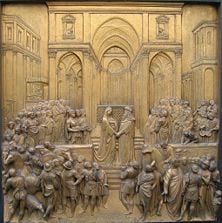
Boccaccio's On Famous Women (De Mulieribus Claris) follows Josephus in calling the Queen of Sheba, Nicaula. Boccaccio goes on to explain that not only was she the Queen of Ethiopia and Egypt, but also the queen of Arabia. She is related to have had a grand palace on "a very large island" called Meroe, located someplace near the Nile river, "practically on the other side of the world." From there, Nicaula crossed the deserts of Arabia, through Ethiopia and Egypt, and up the the coast of the Red Sea, to come to Jerusalem to see "the great King Solomon."[6]
Christine de Pizan's The Book of the City of Ladies continues the convention of calling the Queen of Sheba, Nicaula. Piero della Francesca's frescoes in Arezzo (c. 1466) on the Legend of the True Cross, contain two panels on the visit of the Queen of Sheba to Solomon. The legend links the beams of Solomon's palace (adored by Queen of Sheba) to the wood of the crucifixion. The Renaissance continuation of the metaphorical view of the Queen of Sheba as an analogy to the gifts of the Magi also is clearly evident in the Triptych of the Adoration of the Magi (c. 1510), by Hieronymus Bosch. Bosch chooses to depict a scene of the Queen of Sheba and Solomon in an ornately decorated collar worn by one of the Magi.[7]
Christopher Marlowe's Doctor Faustus refers to the Queen of Sheba as Saba, when Mephistopheles is trying to persuade Faustus of the wisdom of the women with whom he supposedly shall be presented every morning.[8]
While there are no known traditions of matriarchal rule in Yemen during the early first century C.E., the earliest inscriptions of the rulers of Dʿmt in northern Ethiopia and Eritrea mention queens of very high status, possibly equal to their kings.[9]
Possible locations for the Kingdom of Sheba
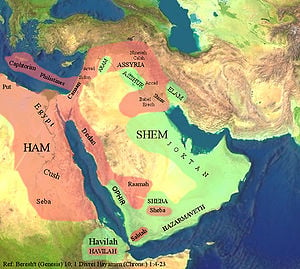
The tradition of the Candaces is well documented in Nubia, where the rule of its many queens recedes into prehistoric times. The Kentakes is a term used to describe the long tradition of leadership in Nubia by warrior queens. Nubia was south of Ancient Egypt, also divided by the Nile River and bordered by the Red Sea. It is another candidate for the location of Sheba and the famous queen. The history of Nubia provides examples of a tradition and a wealthy kingdom that could be the original kingdom of the Queen of Sheba. The economics of the culture was based upon trade. David Jones, in Women Warriors: a History, relates that in 332 B.C.E. Alexander the Great attempted to lead his army into Nubia. At its border, he was confronted with the brilliant military formation devised by their warrior queen, Candace of Meroë. She led her army in the opposition from on top of an elephant. Alexander withdrew and redirected his forces to enter Egypt instead.[10] It should be noted that this story is thought by scholars to be legendary, and Alexander appears never to have attacked Nubia. The whole story of Alexander and Candace's encounter appears to be fictitious.[11] That was the beginning of the Greek rule of Egypt that would last for three hundred years until the Roman occupation in 30 B.C.E.
Strabo also describes a similar clash with the Romans, in which the Roman army was defeated by Nubian archers under the leadership of another queen of Nubia. This queen was described as "one-eyed," being blind in one eye or represented only in profile.[12] The strategic formations used by this second queen are well documented in Strabo's description of her victory.
Old Kingdom Egyptian accounts of trade missions first mentioned Nubia in 2300 B.C.E. The Egyptians imported gold, incense, ebony, ivory, and exotic animals from tropical Africa through Nubia. Aswan, right above the First Cataract, marked the southern limit of Egyptian control. As trade between Egypt and Nubia increased, so did wealth and stability.
By the sixth dynasty of Egypt, Nubia was divided into a series of small kingdoms. Scholars debate whether these peoples, who flourished from c. 2240 B.C.E. to c. 2150 B.C.E., were the result of another internal evolution, wars, or invaders. The Sahara Desert was becoming too arid to support human beings. During the Egyptian Middle Kingdom (c. 2040–1640 B.C.E.), Egypt began expanding into Nubia to gain more control over the trade routes in Northern Nubia and direct access to trade with southern Nubia. They erected a chain of forts down the Nile below the Second Cataract in the river. These garrisons seemed to have had peaceful relations with the local Nubian people, but little interaction during the period.
A contemporaneous, but distinct, culture was the Pan Grave culture, so called because of their shallow graves. Shallow graves produced mummies naturally. The Pan Graves are associated with the eastern bank of the Nile, but the Pan Graves and western groups definitely interacted. The Kingdom of Kerma arose as the first kingdom to unify much of the region. It was named for its presumed capital at Kerma, one of the earliest urban centers in tropical Africa. By 1750 B.C.E., the rulers of Kerma were powerful enough to organize the labor for monumental walls and structures of mud brick. They created rich tombs with possessions for the afterlife and large human sacrifices. The craftsmen were skilled in metalworking and their pottery surpassed in skill that of Egypt. Excavated sites at Kerma yielded large tombs and a palace-like structure ('Deffufa'), alluding to the early stability in the region.
The early tradition of astronomical observations in Nubia is reflected by the presence of megaliths discovered at Nabta Playa that are examples of what seem to be the world's first Archaeoastronomy devices, predating Stonehenge by at least 1000 years.[13] According to one authority, the complexity observed at Nabta Playa, likely formed the basis for the structure of both the Neolithic society at Nabta and the Old Kingdom of Egypt.[14] Hence, the long tradition of studying the stars and the sun such as the references in the Old Testament, and the knowledge of new phenomena provoking the travel of the Magi.
Some modern Arab academics have placed the Queen of Sheba as a ruler of a trading colony in Northwest Arabia, established by South Arabian kingdoms. Modern archaeological finds do confirm the fact that such colonies existed with South Arabian script and artifacts, although nothing specific to Balqis or Bilqis, the Queen of Sheba, has been uncovered.
Recent archaeological discoveries
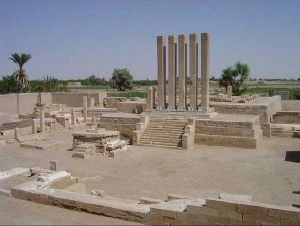
Recent archaeological discoveries in the Mahram Bilqis (Mahram Bilkees, "Temple of the Moon Deity") in Mareb, Yemen, support the view that the Queen Sheba ruled over southern Arabia, with evidence suggesting the area to be the capital of the Kingdom of Sheba.
A team of researchers funded by the American Foundation for the Study of Man (AFSM) and led by University of Calgary archaeology professor, Dr. Bill Glanzman, has been working to "unlock the secrets of a 3,000-year-old temple in Yemen." "We have an enormous job ahead of us," said Glanzman in 2007. "Our first task is to wrest the sanctuary from the desert sands, documenting our findings as we go. We're trying to determine how the temple was associated with the Queen of Sheba, how the sanctuary was used throughout history, and how it came to play such an important role in Arab folklore."[15]
A theory has been voiced that the meeting between the Queen of Sheba and Solomon was not for love or admiration, but a discussion about trade. According to the Bible, Solomon built a fleet of ships at Ezion-geber. The theory is that Solomon intended to sail to East Africa routinely and there trade, bypassing the South Arabian kingdom of Sheba which previously acted as middleman in this trade.
The revisionist historian Ralph Ellis suggests that the Queen of Sheba (Seba) may have been the queen of Pharaoh Psusennes II, who ruled in Lower Egypt and whose Egyptian name was Pa-Seba-Khaen-Nuit. He suggests that the link between this queen and Ethiopia may have been derived from the Kebra Negast, which indicates that the eastern borders of Ethiopia terminated at Gaza and Jerusalem (KN 92).
Notes
- ↑ Geocities, Hatshepsut, the Queen of Sheba, and Immanuel Velikovsky. Retrieved June 24, 2008.
- ↑ David Allen Hubbard, The Literary Sources of the Kebra Nagast (St. Andrews, 1954), p. 303f.
- ↑ Vickie Byrd (ed.) Queen of Sheba: Legend and Reality (Santa Ana, California: The Bowers Museum of Cultural Art, 2004), p. 17.
- ↑ Stephen Murray, The Portals: Access to Redemption. Retrieved June 24, 2008.
- ↑ Vickie Byrd (ed.), Queen of Sheba: Legend and Reality (Santa Ana, California: The Bowers Museum of Cultural Art, 2004), p. 17.
- ↑ Giovanni Boccaccio, Famous Women translated by Virginia Brown (London: Harvard University Press, 2001, ISBN 0-674-01130-9).
- ↑ Web Gallery and Art, Triptych of the Adoration of the Magi. Retrieved June 24, 2008.
- ↑ Christopher Marlowe, Doctor Faustus and Other Plays (Oxford World Classics).
- ↑ Rodolfo Fattovich, "The 'Pre-Aksumite' State in Northern Ethiopia and Eritrea Reconsidered" in Paul Lunde and Alexandra Porter ed., Trade and Travel in the Red Sea Region(Archaeopress, Oxford: 2004), p. 73.
- ↑ David E. Jones, Women Warriors: A History (Brasseys, Inc., 2000).
- ↑ David M. Gutenberg, The Curse of Ham: Race and Slavery in Early Judaism, Christianity, and Islam (Princeton University Press, 2003).
- ↑ Carolyn Fluehr-Lobban, Nubian Queens in the Nile Valley and Afro-Asiatic Cultural History. Retrieved July 14, 2008.
- ↑ PlanetQuest, The History of Astronomy. Retrieved August 29, 2007.
- ↑ Fred Wendorf, Late Neolithic megalithic structures at Nabta Playa. Retrieved June 24, 2008.
- ↑ University of Calgary, Arabian desert surrenders Queen of Sheba's secrets. Retrieved June 24, 2008.
References
ISBN links support NWE through referral fees
- Budge, E.A. Wallis. The Queen of Sheba & Her Only Son Menyelek a/k/a The Kebra Nagast. Research Associates School Times Publications, 2000. ISBN 978-0948390425.
- Clapp, Nicholas. Sheba: Through the Desert in Search of the Legendary Queen. Houghton Mifflin, 2001. ISBN 978-0395952832.
- de Maigret, Alessandro. Arabia Felix. Translated Rebecca Thompson. London: Stacey International, 2002. ISBN 1-900988-07-0.
- Gartner, Rosanne. Meet the Queen of Sheba: More Dramatic Portraits of Biblical Women. Judson Press, 2001. ISBN 978-0817013950.
- Korotayev, Andrey. Ancient Yemen. Oxford: Oxford University Press, 1995. ISBN 0-19-922237-1.
- Leeman, Bernard. Queen of Sheba and Biblical Scholarship. Queensland Academic Press, 2005. ISBN 0-9758022-0-8.
External Links
All links retrieved December 7, 2022.
- Makeda, Queen of Sheba by Torrey Philemon.
- Queen of Sheba Temple restored (2000, BBC)
- The Queen Of Sheba by Michael Wood and the BBC.
Credits
New World Encyclopedia writers and editors rewrote and completed the Wikipedia article in accordance with New World Encyclopedia standards. This article abides by terms of the Creative Commons CC-by-sa 3.0 License (CC-by-sa), which may be used and disseminated with proper attribution. Credit is due under the terms of this license that can reference both the New World Encyclopedia contributors and the selfless volunteer contributors of the Wikimedia Foundation. To cite this article click here for a list of acceptable citing formats.The history of earlier contributions by wikipedians is accessible to researchers here:
- Queen of Sheba history
The history of this article since it was imported to New World Encyclopedia:
- History of "Queen of Sheba"
Note: Some restrictions may apply to use of individual images which are separately licensed.
↧ Download as ZWI file | Last modified: 02/03/2023 23:46:33 | 33 views
☰ Source: https://www.newworldencyclopedia.org/entry/Queen_of_Sheba | License: CC BY-SA 3.0
 ZWI signed:
ZWI signed: KSF
KSF